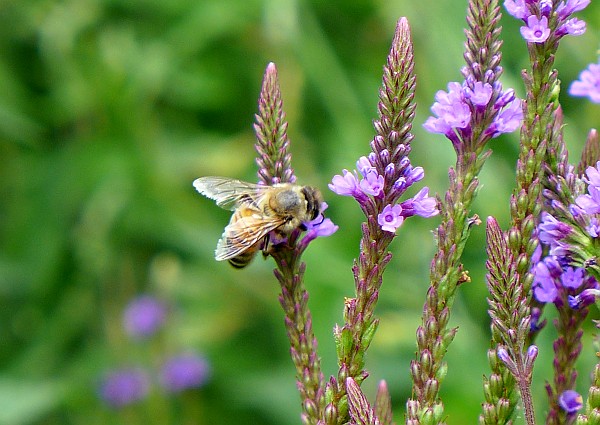
August flowers have broken the nectar dearth.
This honeybee is feeding at blue vervain (Verbena hastata) in Schenley Park.
(photo by Kate St. John)

August flowers have broken the nectar dearth.
This honeybee is feeding at blue vervain (Verbena hastata) in Schenley Park.
(photo by Kate St. John)
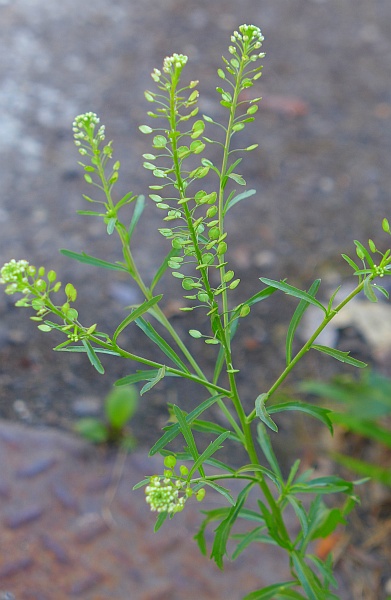
30 July 2014
Here’s a pretty plant that grows in ugly places.
Peppergrass (Lepidium virginicum) is a native edible member of the mustard (Brassicaceae) family that occurs naturally in North and Central America. Sometimes it’s cultivated for its peppery taste. The young rosette leaves taste like mild arugula and the round flat seed pods, when chewed, are a substitute for black pepper.
However most of us know this plant — if we notice it at all — for its indomitable attitude toward degraded habitat. It will grow almost anywhere, a trait that has given it the status of “Weed.”
I found this one growing from a crack in the sidewalk of the Greenfield Bridge.
Though one could eat the seed pods from a roadside specimen, don’t do it! The soil next to a busy road is contaminated with toxic metals from car and truck exhaust. Plants in the Brassicaceae family are such good hyperaccumulators of metals that they can be used to clean up toxic top soil. This roadside plant is full of toxins.
If you decide to taste peppergrass, look for a plant that’s in good clean soil far from the road.
(photo by Kate St. John)
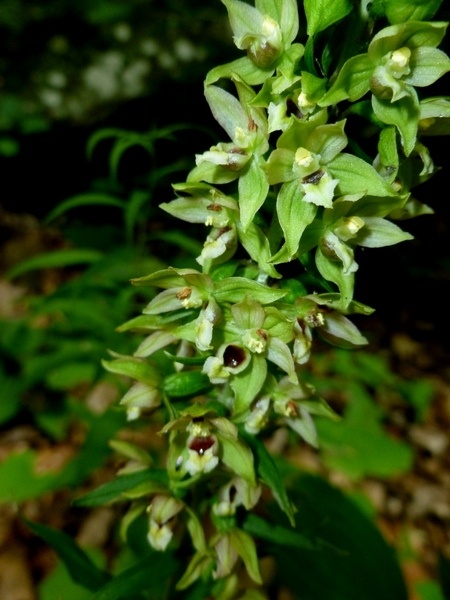
Dick Nugent pointed out — and I’ve noticed too — that this is a particularly good year for Helleborine orchids in western Pennsylvania.
Dick wrote:
This year we have a Helleborine Orchid blooming in our yard. It magically appeared in one of our flower beds. Helleborine is one of the most common orchids in PA. It is an alien species and may be slightly invasive (I have trouble thinking of an orchid as being invasive)[*]. I have been finding them all over western PA in a wide variety of habitats. They are blooming right now and frequently grow on the shoulder of roads and trails. Like many orchids, I suspect that this one has tiny seeds which are spread by the wind. It is a small flower with many flowers on one stalk. Through a magnifying glass the flower is really pretty.
Dianne Machesney photographed these at McConnell’s Mill State Park. Here’s a close-up of the flower.
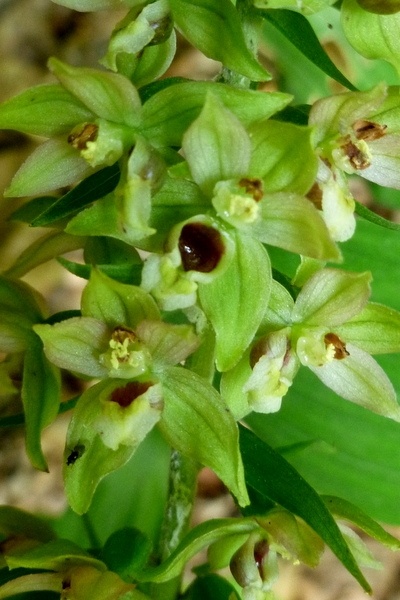
The common name got me wondering… Is “Helleborine” a reference to the Greeks as in “Hellenic?” No. The name means “like Hellebore,” a European genus in the buttercup family. The word began as “ellebore” and acquired a leading H. Though it doesn’t refer to the Greeks, both Hellebore and Helleborine are foreign plants to North America.
I’m always thrilled to see an orchid, even if it’s an alien.
(photo by Dianne Machesney)
[*] p.s. The species at this link Epipactis helleborine is invasive.
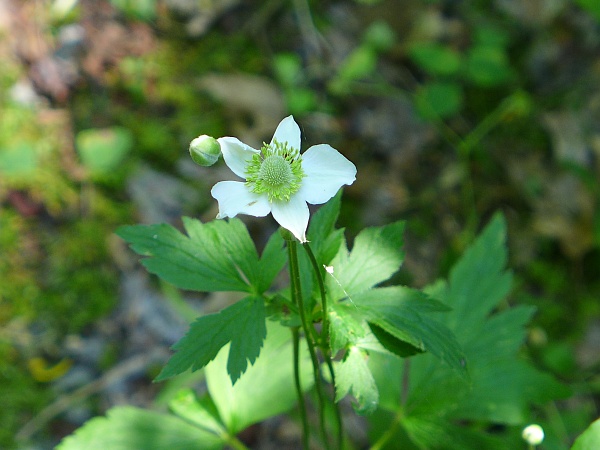
There aren’t many flowers that bloom in the woods in the summer, but you might find this one.
Thimbleweed (Anemone virginiana) stands 2-3 feet tall in the sun-splashed forest. The flower has an elongated central disk surrounded by large white petals and is noticeable because it’s alone on a long stalk above the leaves.
When the flower is fertilized, the petals fall off and the central disk becomes a seed pod. It looks like a thimble, hence the name.
I found this one blooming at the Roaring Run Watershed in Armstrong County last weekend.
(photo by Kate St. John)
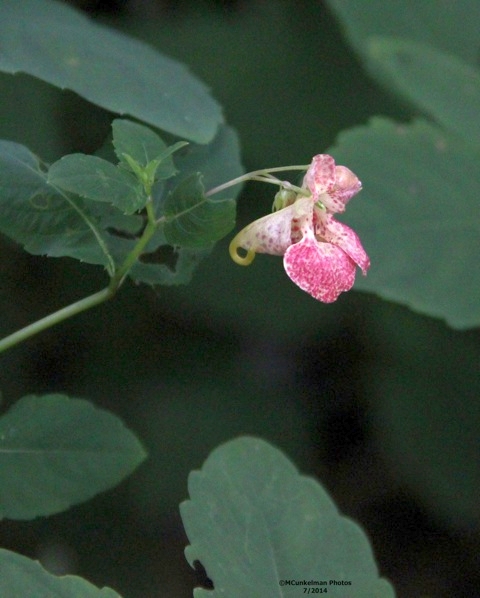
I’ve seen yellow and orange touch-me-not but here’s a rare jewelweed in pink.
Thanks to Marcy Cunkelman for sending this along. It blooms in her garden.
(photo by Marcy Cunkelman)
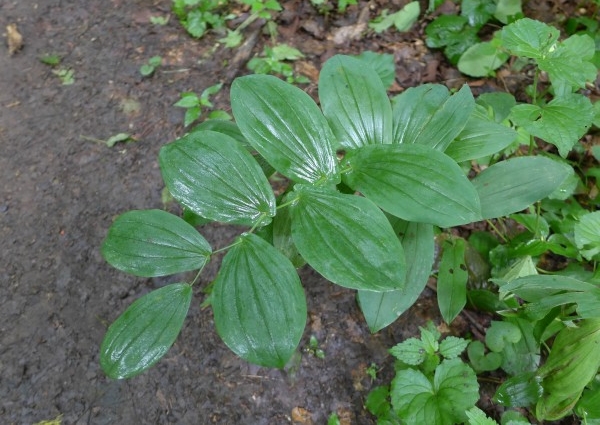
Today we’ll have a plant identification quiz. I have an answer but you may have a better one.
I found this plant on June 29 at Dead Man’s Hollow in Allegheny County. The leaves are so distinctive that its identity begs for some detective work. Here are the clues I gathered:
Leaves:
The plant had no flowers and no buds. Instead it had developing fruits which gave me clues about the flowers. Here are two photos of the fruits.
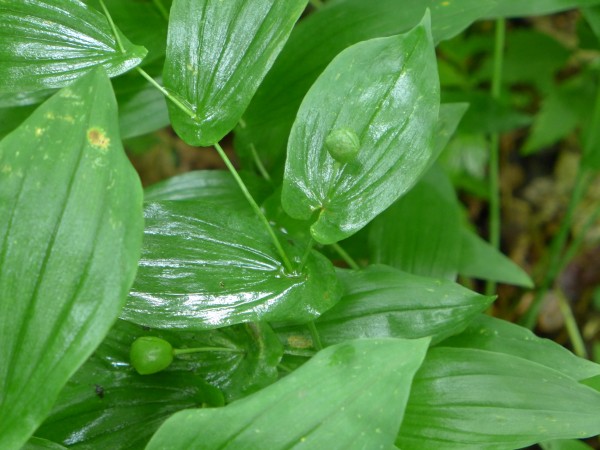
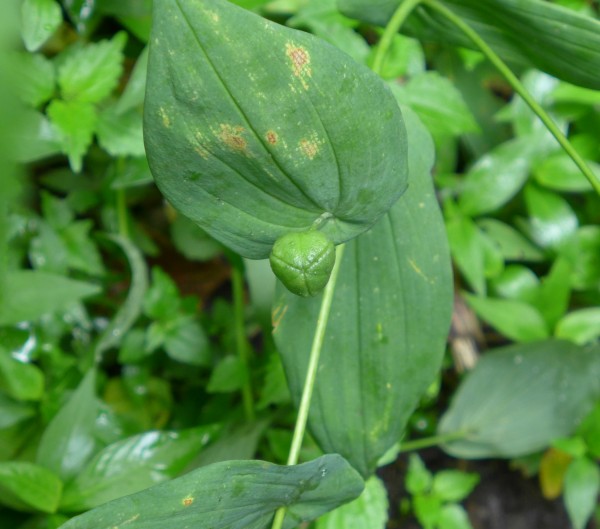
The fruits are:
I looked up “six petals with alternate, entire leaves” in my Newcomb’s Wildflower Guide and found a familiar spring wildflower with perfoliate leaves.
However, I am not completely satisfied with my identification. I have never seen “my plant” arc horizontally like this when it’s blooming and the fruits in the illustration look different. Is my Newcomb’s Guide missing a species? Have I never noticed that the plant “lies down” in the summer? Are the fruits going to match the illustration when they mature in a few weeks?
So here’s the quiz: What plant is this?
Leave a comment with your answer. I’ll post my guess after I’ve heard from you.
UPDATE: It is large-flowered bellwort (Uvularia grandiflora). See the Comments for a link to the flowering version of this plant.
(photos by Kate St. John)
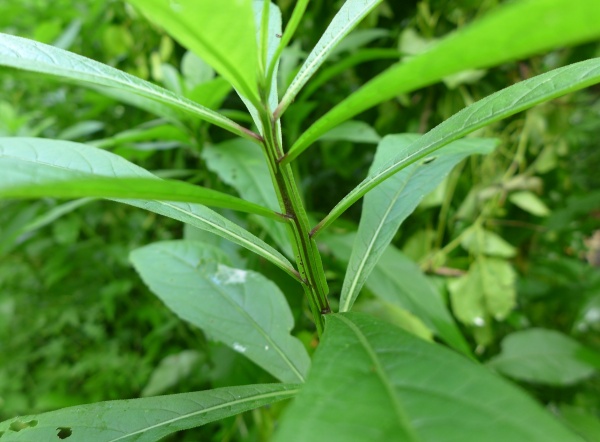
Two months before it blooms we can identify this plant even though it has no flowers. Look at its stem!
Wingstem (Verbesina alternifolia) is already five feet tall and on its way to eight. It will look like this in August. Meanwhile the stem gives away its name.
The “wings” are petiole extensions that run the length of the stem. The newest wings at the top of the plant are straight with a dark margin. The older part of the stem has long white hairs in the margins. Sometimes the wings are wavy.
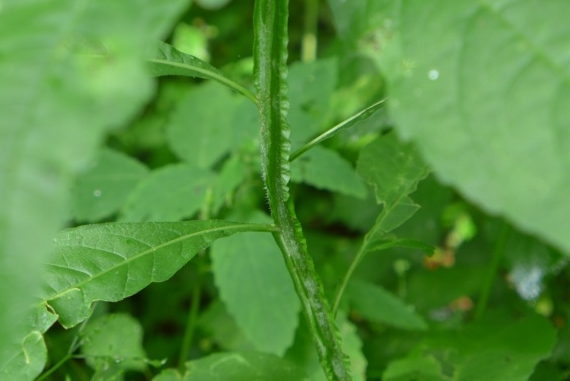
To me the wings look like flanges. “Flange-stem?”
Say that three times quickly and you’ll know why it’s called wingstem!
(photos by Kate St. John)
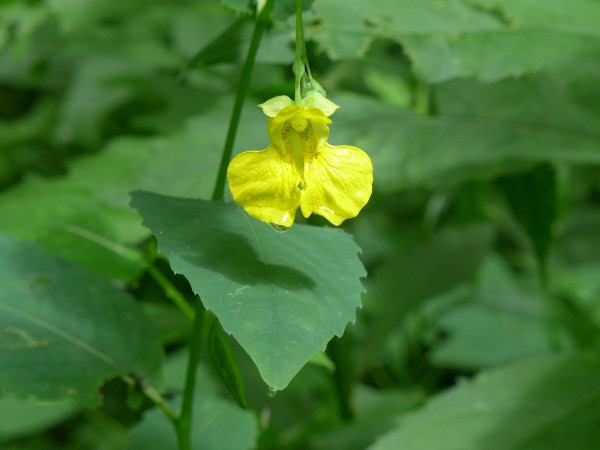
Blooming now in southwestern Pennsylvania, Pale Touch-me-not (Impatiens pallida) beacons to bees with its yellow landing pad.
(photo by Kate St. John)
also called yellow jewelweed
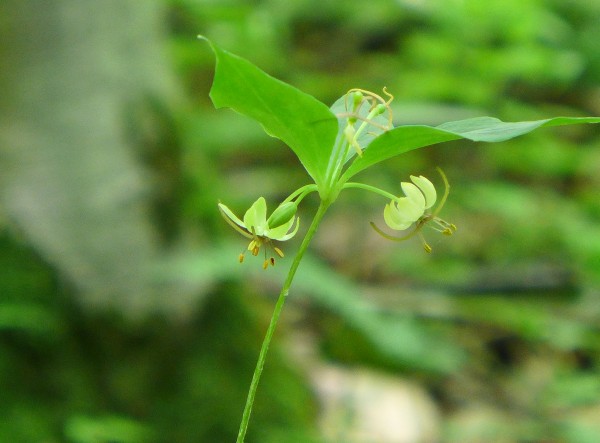
It seems odd that a plant would have green flowers but a surprising number do including jack-in-the-pulpit, northern green orchid and ragweed.
In mid-June I found a blooming Indian cucumber root (Medeola virginiana) that I nearly missed because the flowers didn’t stand out. The top two had already gone to seed and those in bloom were camouflaged in a greenish yellow way.
The bottom whorl of leaves caught my attention. It’s typically five to nine long leaves (this one had seven) suspended a foot or so above the ground. Only the blooming plants have the smaller top whorl too.
I tried to take a picture of this arrangement but even my best photo is confusing. The small flower whorl blends in with a second plant behind it even though the background is beyond the mossy log.
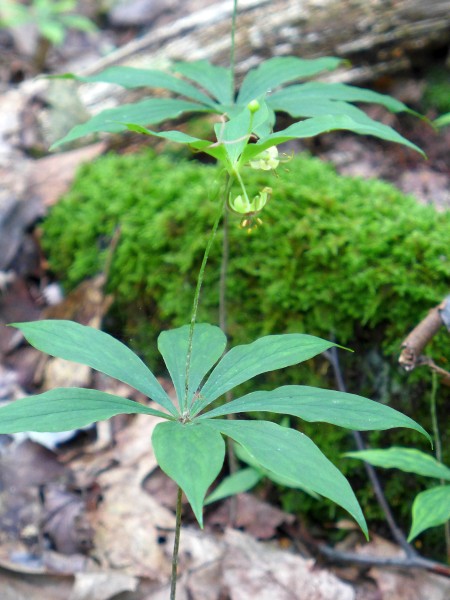
Having paused to take a photo I knelt down to see the flowers. This perennial is pollinated by insects, probably flies. The color green makes sense for flies as they don’t need fancy red, white, yellow or purple to be attracted to the plant.
Indian cucumber root earned its common name when Native Americans taught the settlers that the edible root smells and tastes like cucumber. People still dig and eat it today, thereby destroying the plant. It’s endangered in Illinois and Florida.
Though not threatened in Pennsylvania, I won’t say the exact location of this flower. Only that I found it in the Laurel Highlands, an area encompassing 3,000 square miles.
(photos by Kate St. John)
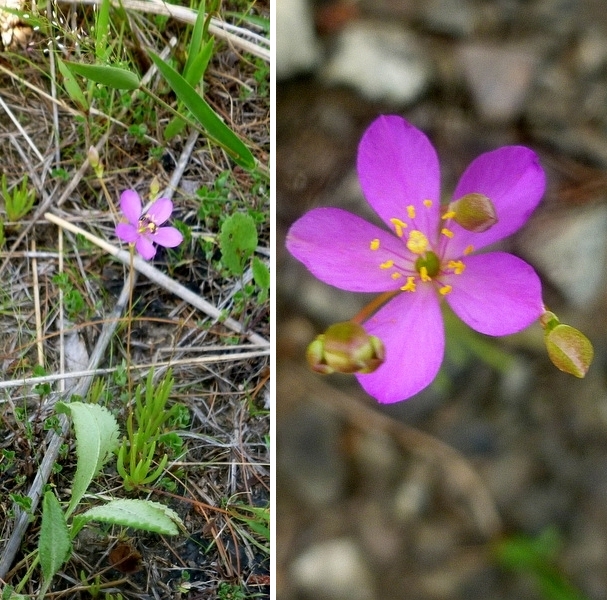
This Pennsylvania threatened plant is in the Portulacaceae family, related to our garden variety Portulaca. Look closely at its thin, round, succulent leaves and you’ll see the family resemblance.
Round-leaved fameflower (Talinum teretifolium), also called Quill fameflower and (Phemeranthus teretifolius), is found in rocky or sandy soil from Pennsylvania southward to Georgia and Alabama.
Dianne Machesney found this one last week at serpentine barrens in Chester County.
It was a Life Flower(*) for her. It would be one for me, too.
(photos by Dianne Machesney)
(*) Life Flower: Borrowing a term from birding, this means the first time one has ever seen this species.